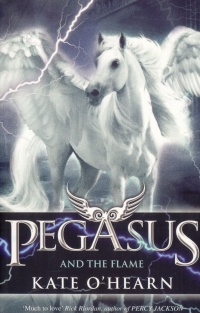| ________________
CM . . .
. Volume XX Number 12. . . .November 22, 2013
excerpt:
When New York City is struck by a terrible lightning storm, Emily (aged 12 or 13) is still grieving for her mother who died of cancer three months earlier. While her policeman father is out on duty, Emily braves the storm to investigate the loud thump she heard on the top of her apartment building, and there she finds that Pegasus – the real, living, winged horse of Roman mythology – has crash-landed in her mother’s rose garden. Desperate to help the injured Pegasus, Emily turns for assistance to Joel, a tough boy she knows from school. Joel may be surly and capable of beating anybody up, but he also constantly draws images of one thing – Pegasus. Meanwhile, one of the Olympian immortals, Paelen the Magnificent, whom Pegasus holds responsible for his wounds, has been captured by the CRU, a top-secret, sinister, government agency. Paelen unwittingly sets sadistic Agent J of the CRU on a hunt for Pegasus. The winged horse, Emily, and Joel flee not only the CRU but also the Nirads, mysterious beings who have invaded Olympus and are after Pegasus. Diana, one of the few surviving Olympians, and Emily’s father, Steve, join Emily, Joel, and Pegasus. The five begin a quest for Pegasus’ golden bridle and for the Daughter of Vesta, a mortal girl who, alone, can self-sacrificially reignite the Flame of Olympus, the source of the gods’ power and the only way to save the world. Paelen, shape-stretcher and thief, also has a part to play as he attempts to atone for his deeds. Pegasus and the Flame’s main addition to modern-day recreations of mythology is its emphasis on the Roman pantheon, instead of the Greek gods, and on the character of Pegasus. Unfortunately, the characters are not compelling enough to make the story interesting. Emily has no real agency. Her instinctive feelings of love for Pegasus seem to be her main motivation, yet that love is told, rather than shown, and she comes across as a passive 14 or 15-year-old who puts a “just” before everything she says, rather than an active 12 or 13-year-old. In fact, almost all of the characters, particularly the women, are wimpy. Carol, the girlfriend of a friendly soldier the children meet, is “terrified” and “[doesn’t] have the stomach” to help them. The goddess Diana is frequently furious, yet her anger is oddly impotent, and she functions more as a source of information than as a real ally. Despite frequent declarations that she will punish humans for their crimes, Diana does nothing of the sort. (The most powerful scene in the book is when Diana sees the condition of two neglected horses in a New York stables and expresses her outrage that humans allow such cruelty. Unfortunately, Diana is only allowed to talk, not act.) Joel’s transformation from sullen orphan to loyal friend is predictable, as is Steve’s choice to defy the law and Paelen’s (slight) character development. Even the evil Agent J is one-dimensional. (Although his presence serves as an indictment of the American government’s sanctioning of torture.) Although emotions are supposed to be the driving force behind this story, none of them feel real, not even Emily’s grief for her mother. Even the ending felt underdeveloped, perhaps because it left too many things unexplained, and not in a “the-sequel-is-coming” way. Plots twists were easily foreseeable. The pace is fairly fast, as scenes alternate between Emily and Paelen, although there is little action until the second half of the book. There is an offensive passage near the end of story, a scene in which Diana informs Emily that it is the love Emily bore for her mother that allowed the Nirads to invade and conquer Olympus. When her mother died, “grief overwhelmed [Emily],” Diana explains, which dimmed her inner Flame and doomed the world. Love is to blame. Natural grief for her dead mother is presented as a problem. And Emily finds that the hole in her heart is healed by Pegasus: because she has the winged horse, she no longer misses her mother – who had died only three months before. Not Recommended. Janet Eastwood is a student in the Master of Children’s Literature program at the University of British Columbia in Vancouver, BC.
To comment
on this title or this review, send mail to cm@umanitoba.ca.
Copyright © the Manitoba Library Association. Reproduction for personal
use is permitted only if this copyright notice is maintained. Any
other reproduction is prohibited without permission.
NEXT REVIEW |
TABLE OF CONTENTS FOR THIS ISSUE
- November 22, 2013.
AUTHORS |
TITLES |
MEDIA REVIEWS |
PROFILES |
BACK ISSUES |
SEARCH |
CMARCHIVE |
HOME |
